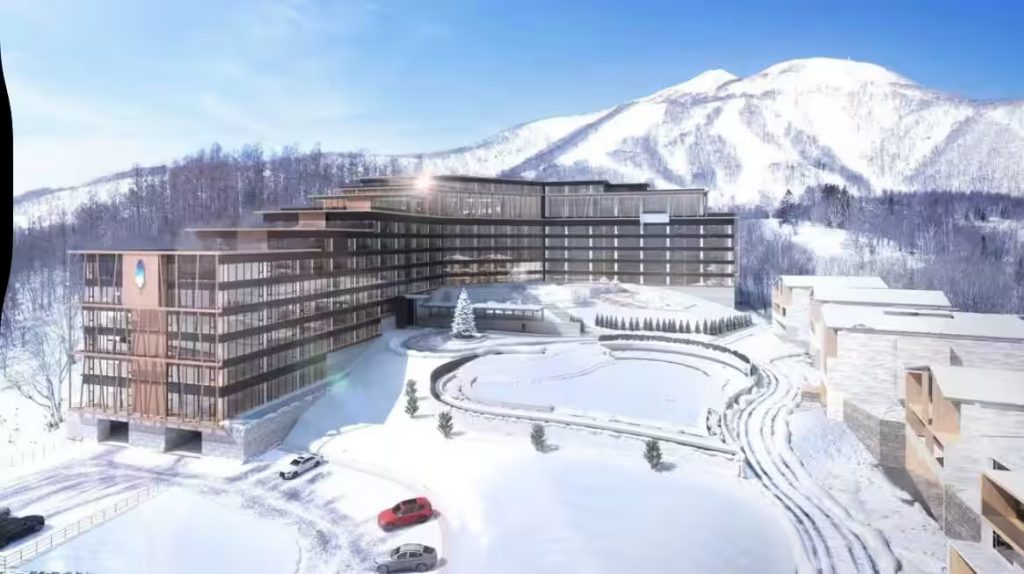
Artist’s rendering of La Plume Niseko Resort (via Instagram)
このページを 日本語 で読む
A Chinese-affiliated company behind one of the largest resort developments in Niseko, Hokkaido, has gone bankrupt. In recent years, the Niseko area has seen soaring land prices and labor costs driven by an influx of foreign capital, dramatically transforming the town.
But now that a major China-backed project has failed, risks associated with foreign investment are becoming more visible. Locals are increasingly worried that this may be a sign of a looming bubble burst.
Niseko grew into a world-class resort, beloved by skiers for its top-quality powder snow. In one corner of Hirafuzaka, the heart of the resort area in Kutchan Town, stands a half-finished building now covered with tarps.
This is a condominium complex under development by La Plume Niseko Resort SPC, a Tokyo-based special-purpose company. In April 2025, the Tokyo District Court declared the company bankrupt. Construction halted last autumn.
The plan had been to build Niseko's largest accommodation facility, with 219 guest rooms and five private villas. According to insiders, the project stalled with only about 30% completed after payments to a local construction company fell behind.
Debt Soars Into Billions
La Plume, founded in December 2020, was a project led by a Chinese-affiliated firm, the bankruptcy trustee's legal representative confirmed. A Japanese local subsidiary of a Chinese company had acquired the land and begun development, but cash flow problems caused the project to collapse.
Total debt is expected to run into the tens of billions of yen. The creditor, a construction company, filed for bankruptcy proceedings with the court, which approved the request.
Niseko, whose name comes from the Ainu word meaning "sharp cliff," began booming after the September 11 attacks in 2001, when Australian skiers began avoiding North America and turned their attention to Japan. Investments by wealthy foreigners became a trend, and Niseko gained international fame as a luxury ski resort. However, following the COVID-19 pandemic, Australian investment slowed, while investment from China, Hong Kong, and South Korea surged.

Pushed by the ever-increasing investment demand, land prices have continued to soar. According to the Ministry of Land, Infrastructure, Transport and Tourism's 2025 land value survey, residential land prices in Kutchan rose 9.7% from the previous year to ¥181,000 JPY ($1,167 USD) per square meter.
Commercial land around Hirafuzaka exceeded ¥500,000 ($3,225) per square meter — more than double what it was a decade ago. In 2020, the town saw the highest nationwide growth in both residential and commercial land prices.
Hourly Wages Top ¥2,000
Tourist numbers continue to climb. According to Kutchan Town, in fiscal 2023, the total number of foreign overnight stays in the Niseko area (including Niseko, Rankoshi, and Kutchan) reached 738,800. This marked the highest figure on record since data collection began in 2006.
On the flip side, wages for hotel and restaurant staff serving foreign tourists have skyrocketed. During the peak winter season, it's not uncommon for part-time workers to earn over ¥2,000 ($12.90) per hour, even higher than Tokyo rates.
A local restaurant owner in Kutchan said, "If you speak English, ¥3,000 ($19.35) an hour isn't unusual. Naturally, the extra labor costs have to be covered by raising menu prices."
The 'Curry Rice Price Index'
Miso ramen: ¥2,000, Hamburger: ¥3,000. These are common prices on menus during winter in Niseko. Coupled with the weak yen and increasing inbound tourism, social media users have started to mock the area's high prices using the term "Niseko Price."
To dispel this image, the town of Niseko calculated the cost of making curry rice — a household staple — to gauge real living expenses. The March 2025 "Curry Rice Price Index" came to ¥382, about ¥25 cheaper than the national average. A local official said, "There's a growing gap between perceived and actual local conditions. Correcting misinformation is difficult, but we'll continue to provide accurate information."

With a population of 17,000, Kutchan Town counts foreign residents as 20% of its permanent population. The collapse of a Chinese luxury resort plan amid the ongoing Niseko Bubble has fueled local anxiety. If the abandoned hotel project turns into a ruin, it could damage the image of the popular resort.
The bankruptcy trustee's lawyer told The Sankei Shimbun, "We've already inspected the site and are in talks with relevant parties to prevent it from being left as is. While the project's scale and plans may change, we hope to find a way to continue the development in some form."
RELATED:
- How Niseko Became a Ski Resort for the Rich and Famous
- Footprints on Secretive Forest Land Purchases in Japan Lead to China
Author: Kenta Shiraiwa, The Sankei Shimbun
このページを 日本語 で読む







